The
Music of the Missions
| † | | † |
| | Today
you can fly there but 450 years ago a wilderness lay beyond the falls |
| In
this story we join music student Imogen Hares who in 1998 travelled to the heart
of South America to find the lost music of the 18th century Jesuit Missions of
the 'Green Hell' | An
Immense Land Parts
of this immense land are still unexplored. It's a world of scrub forest, huge
swamps and two of South America's greatest rivers, the Paraguay and the Parana.
Floods are common - on one occasion the water was so high that these falls virtually
disappeared. Huge trees were thrown about like toys. The spray could be seen from
miles away rising above the forest like a plume of white smoke and the roar was
deafening.
Here was the homeland of numerous tribes, some nomadic, or
simple fishermen, or hunters. On the way they collected honey, insect grubs and
a few wild berries. Not too long ago their ancestors used the shells of giant
armadillos for shelter. Today the land is shared by three countries Argentina,
Paraguay and Bolivia. The central part is known as the Chaco. The
Green Hell 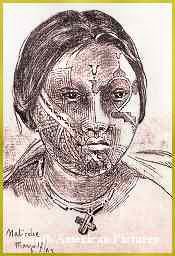
The
first European to cross this Green Hell between the Atlantic and the Andes mountains
far to the west was a Portuguese sailor, Alejo García. He joined
a band of wandering Guaraní for the journey but never survived to tell
his story. He was murdered on the way back to the coast. Alejo García was
following a trail of silver known to the native Americans. They said it came from
distant mountains. The race to reach the silver treasures in the Andean
realm of the Inca/ Inka had started.
The route through the 'Green Hell' was terrible and as history tells it was Francisco
Pizarro from Trujillo in Extremedura, Spain who was the first to get the prize.
Pizarro reached the Andes from the Pacific side. Numerous
adventurers followed Alejo García and in 1661 a Spaniard,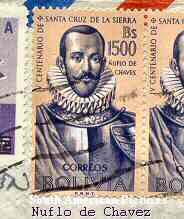 Ñuflo de Chávez reached the foot of the Andes and founded the city
of Santa Cruz de la Sierra, a name he gave after his home village in Extremadura,
Spain. The next three centuries saw little progress with the route. In fact
there was a political tension between the Spanish who had settled in the east
and those who controlled fabulous silver mines in the west. The native Americans
were hostile and The Green Hell remained something of a no-mans' land. The Spanish
authorities would have welcomed true settlement but it never happened. Just a
few fortified outposts were established around the Chaco and it was left to the
determined followers of the Society of Jesus, the Jesuits to pentrate the wilderness
and 'pacify' the native Americans. The Jesuits were active throughout South America
but they are most remembered for their dedication to the remote lands of the Paraguay,
Parana Rivers and the Chaco. There they built an almost autonomous state, out
of reach of the Spanish goverment. One nucleus of Jesuit power was in Chiquitos
some 300kms northeast of Santa Cruz de la Sierra, Bolivia.
Ñuflo de Chávez reached the foot of the Andes and founded the city
of Santa Cruz de la Sierra, a name he gave after his home village in Extremadura,
Spain. The next three centuries saw little progress with the route. In fact
there was a political tension between the Spanish who had settled in the east
and those who controlled fabulous silver mines in the west. The native Americans
were hostile and The Green Hell remained something of a no-mans' land. The Spanish
authorities would have welcomed true settlement but it never happened. Just a
few fortified outposts were established around the Chaco and it was left to the
determined followers of the Society of Jesus, the Jesuits to pentrate the wilderness
and 'pacify' the native Americans. The Jesuits were active throughout South America
but they are most remembered for their dedication to the remote lands of the Paraguay,
Parana Rivers and the Chaco. There they built an almost autonomous state, out
of reach of the Spanish goverment. One nucleus of Jesuit power was in Chiquitos
some 300kms northeast of Santa Cruz de la Sierra, Bolivia. |
| Santa
Cruz de la Sierra - Bolivia |
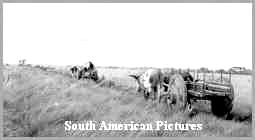 |
When
Bolivia gained independence from Spain in 1823, the lands granted to the young
Republic included the northwestern Chaco and Santa Cruz de la Sierra. The city
became the centre of a Department in 1826. For much of the 19th century
and well into the 21st Santa Cruz was isolated. | |
Whichever way they
chose it took a very hardy traveller to make the journey whether from the Andean
side or from Paraguay. To put this in perspective, the first hard-topped
road link to Cochabamba, the nearest Bolivian city was not completed until 1950.
Ten years later the streets of the city were still unpaved and deep in mud. The
best local transport was a horse, after that a wooden cart drawn by oxen, and
for a few - the 'Willys Jeep'. | 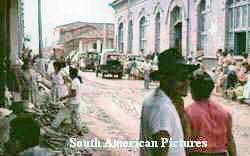 |
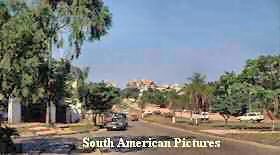 |
All
that has changed and Santa Cruz is now one of the fastest growing and prosperous
cities in South America. It is rich from the agricultural land that was once forest
and from natural resources such as oil, gas and iron ore. From a population of
60,000 just 45 years ago Santa Cruz is now home to over a million. |
| |
The
Jesuit Missions of Chiquitos |
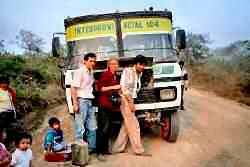 |
Once
away from extensive level, open farmland that has brought prosperity to Santa
Cruz, roads to the east lead to undulating hills, covered with remnants of forest.
The name Chiquitos comes from Chiquito a local native American tribe. Imogen
Hares a music student travelled to the 17th century missions. One journey by bus
along a dirt road took 18 hours. In recent years the main roads have been paved.
In the 17th century Jesuit missions were built around a central courtyard. The
church occupied one side and the bell tower was separate.
|
| Mostly
the churches were wooden with clay tile roofing and over the years they
became derelict. In the late 1970's renovation work began and the Chiquitos
missions are now classed as a 'World Heritage Site'.
Of ten original missions in Chiquitos six have survived - San
Javier, Concepción (right), Santa Ana, San Rafael, San Miguel
and San José de Chiquitos | |
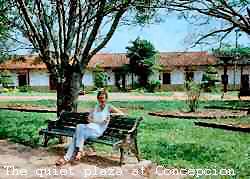 |
|
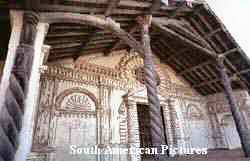 |
Restoration
of the missions at Concepción 1756 (above) and
at San Javier (1692), (left) the oldest of the six, were the work of Father Martin
Schmidt, a priest from the canton of Lucerne in Switzerland and German architect
Hans Roth. Part
of the Jesuit philosophy was to teach the native Americans crafts such as carving,
gilding and painting. The forest people were already skilled in many of these
including woodworking, painting body designs, making weapons and building
their homes. The Jesuits found willing pupils and introduced their European
styles and religious icons.
| By
the mid-18th century, the Jesuits were very successful with their teaching and
all powerful in this part of South America. The Spanish Crown was concerned by
their strength and in 1767 the Jesuits were expelled.
Apart from
a few local settlers who remained, the mission centres were abandoned. |
|
| | The
Music |
| The
priests discovered a latent talent for music among the native Americans. They
introduced European instruments including violins and harps which local craftsmen
copied. The missions soon possessed a repertoire of locally composed hymns and
other music and it was left behind when they were abandoned. Many sheets
somehow survived the tropical climate and the first were unearthed from piles
of old church documents in the 1980's. The work was begun by Gabriel Garrido an
Argentinian specialist in Baroque music | 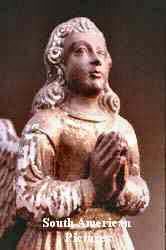 |  | 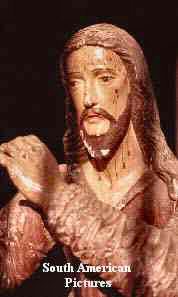 |
| Part
of an original 17th century paper sheet of music used in the Missions of Chiquitos.
The work by Domenico Zipoli from Prato, close to Florence is part
of an extensive collection preserved by Bolivian specialists. This fragment
is from Ave Maria Stella a Vespers hymn sung on Feasts of the Blessed Virgin Mary |
|
| South
American Pictures and Imogen Hares [now Imogen Atkins] would like to thank Piotr
Nawrot SVD, the late Hans Roth and the office and the Director and staff of the
Festival Internaciónal de Musica Renacenista y Barroca Americana
'Misiones de Chiquitos' |
|
|
| The
text and most of the images are © Copyright |
| For
any commercial use please contact | | |
| THE
NONESUCH - FLOWER OF BRISTOL |
| AN
EMBLEM FOR ENTERPRISE | | |
|
|
|